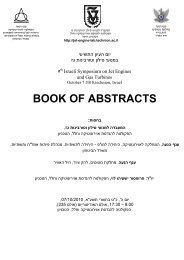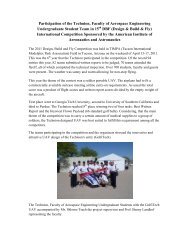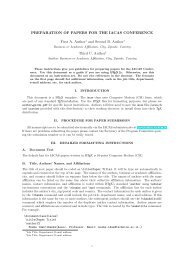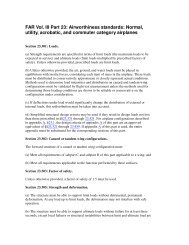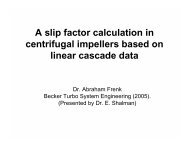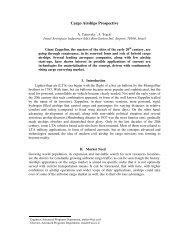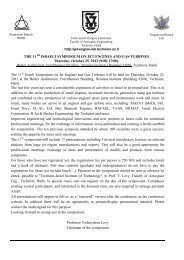A Century of Ramjet Propulsion Technology Evolution - Faculty of ...
A Century of Ramjet Propulsion Technology Evolution - Faculty of ...
A Century of Ramjet Propulsion Technology Evolution - Faculty of ...
You also want an ePaper? Increase the reach of your titles
YUMPU automatically turns print PDFs into web optimized ePapers that Google loves.
In 2004, we are approaching speed ranges entirely unheard <strong>of</strong><br />
to the Wright brothers in 1903 or to Leduc, who in 1957 spoke <strong>of</strong><br />
600-mph limits for aircraft applications. Currently, sufficient knowledge<br />
exists to challenge the upper speed limits <strong>of</strong> pure ramjets<br />
(M ∼ 6–8), dual-mode scramjets (M ∼ 14), and pure or rocketassisted<br />
scramjets (M ∼ 20). Nevertheless, the greatest knowledge<br />
base exists in the Mach 3–7 flight range. Strides have been taken in<br />
recent years to expand this understanding to include the upper region<br />
to orbital speeds, as well as the lower region to static conditions.<br />
It cannot escape notice that since 1990 the international activity in<br />
ramjet and scramjet missile development has increased noticeably.<br />
Very strong international ramjet and scramjet capabilities are being<br />
created through many significant ongoing developments. Whereas<br />
propulsion approaches to future requirements continue to evolve,<br />
it appears that the combination <strong>of</strong> current programs has served to<br />
revive and reinvigorate a new generation <strong>of</strong> industrial and military<br />
capability.<br />
<strong>Ramjet</strong> technology has matured to a high state <strong>of</strong> readiness for<br />
military applications. Greater stand<strong>of</strong>f ranges and reduced time to<br />
target are consistently mentioned in conjunction with future missile<br />
requirements. <strong>Ramjet</strong> or scramjet solutions certainly provide<br />
the kinematic properties desired, but remaining factors such as affordability,<br />
payload integration, inlet packaging, and development<br />
risk all play important roles in a selection process. The attractive<br />
performance attributes <strong>of</strong> ramjet-powered missiles have been available<br />
for over 50 years; however, limited applications have come to<br />
being, at least within the United States Recent advances in integral<br />
booster design may help reduce many system-level concerns, and<br />
advances in targeting and information technology may create the<br />
need for the added range that ramjet propulsion can supply. Hybrid<br />
or mixed cycle ramjet technology is developing to support future<br />
supersonic and high-speed transport. Scramjet technology has matured<br />
considerably in the last 15 years and promises to open this<br />
new century <strong>of</strong> flight with the first flight <strong>of</strong> a scramjet-propelled vehicle<br />
with true potential for enabling space access. Still, substantial<br />
advances are required to support military and reusable launch vehicle<br />
applications. Advanced developments, such as PDE and MHD<br />
technologies, are progressing and show great promise for expanding<br />
the potential <strong>of</strong> high-speed airbreathing vehicles.<br />
On a fundamental level, our understanding is maturing on turbulence<br />
and its effects at higher speeds, on wall shear and heat transfer,<br />
boundary-layer separation and reattachment, fuel injection and mixing,<br />
and chemical kinetics and combustion dynamics in an engine.<br />
CFD is becoming an increasingly important tool in understanding<br />
these fundamental processes, combined with an expanding database<br />
for validating physical and chemical models used. Strides have also<br />
been taken to expand the engineering design database on mixed<br />
cycle engine performance at low and high speeds to complement<br />
the extensive existing database in the Mach 3–7 range. Certainly,<br />
opportunities in research and development continue to exist and<br />
will do so well into this second century <strong>of</strong> ramjet history. To an<br />
aerospace engineer entering our field today, the outlook is bright<br />
and the future exciting. The authors are reminded <strong>of</strong> similar excitement<br />
surrounding the activity leading up to and culminating with<br />
the initial successful landing <strong>of</strong> NASA’s Apollo 13 on the moon in<br />
1969. The authors challenge the international community to maintain<br />
focus and resolve for a consistent effort to realize the promises<br />
for airbreathing flight into this new century as mankind continues<br />
to push back the frontiers <strong>of</strong> flight and seek a better understanding<br />
for our place in the universe.<br />
It is apparent that airbreathing technology has matured to occupy<br />
an important place in the propulsion field. The authors have<br />
only touched the surface <strong>of</strong> the technology. Its future importance,<br />
although hopeful, cannot be foreseen based on past history. It is a<br />
truism that technology feeds on itself, that work in one area <strong>of</strong>ten<br />
is quickly applicable in an entirely different area. We can all contribute<br />
more effectively to using this process and explaining it to<br />
our communities and funding sources to justify its existence. We<br />
must be cautioned against the casual hindsight judgment <strong>of</strong> the idea<br />
whose time had come. More than once, participants were convinced<br />
wrongly that airbreathing’s time had come, were tempted to assume<br />
FRY 57<br />
that a favorite project or system’s existence was inevitable, and found<br />
that this belief contributed to the failure <strong>of</strong> our own purposes. <strong>Ramjet</strong><br />
and scramjet propulsion’s time shall come only after solutions to<br />
challenging technical problems are resolved and the need is clear.<br />
Acknowledgments<br />
The author is deeply appreciative to R. Waesche for our many<br />
years <strong>of</strong> fruitful collaboration and our valuable discussions, based<br />
on his many years <strong>of</strong> experience in the development <strong>of</strong> ramjet technology,<br />
which contributed to this review. The author wishes to acknowledge<br />
the significant contributions made to the state <strong>of</strong> the<br />
art <strong>of</strong> ramjet and scramjet technology by individuals worldwide.<br />
The author gratefully acknowledges constructive reviews by Stuart<br />
Blashill, U.S. Navy; Parker Buckley, Robert Mercier, and F. D. Stull<br />
(retired), U.S. Air Force Research Laboratory; and Chuck McClinton,<br />
NASA Langley Research Center. The author welcomes receipt<br />
<strong>of</strong> additional historical material or references, which can be incorporated<br />
in a future review.<br />
References<br />
1Sloop, J., “Liquid Hydrogen as a <strong>Propulsion</strong> Fuel, 1945–1959,” Forward<br />
by Fletcher, J. C., NASA SP-4404, NASA Scientific and Technical<br />
Informative Office, Washington, DC, April 1977.<br />
2Avery, W. H., “Twenty-Five Years <strong>of</strong> <strong>Ramjet</strong> Development,” Jet<strong>Propulsion</strong>,<br />
Vol. 25, No. 11, 1955, pp. 604–614.<br />
3Thomas, A. N., “Some Fundamental Aspects <strong>of</strong> <strong>Ramjet</strong> <strong>Propulsion</strong>,” Jet<br />
<strong>Propulsion</strong>, Vol. 27, No. 4, 1957, pp. 381–385.<br />
4Courtesy <strong>of</strong> the U.S. Air Force <strong>Propulsion</strong> Directorate, circa 1960s.<br />
5Waltrup, P. J., “Hypersonic Airbreathing <strong>Propulsion</strong>: <strong>Evolution</strong> and Opportunities,”<br />
CP-428, AGARD, April 1987.<br />
6Zucrow, M. J., Aircraft and Missile <strong>Propulsion</strong>, John Wiley and Sons,<br />
NY, Vols. 1 and 2, 1958.<br />
7Dugger, G. L. (ed.), <strong>Ramjet</strong>s, AIAA selected reprints, Vol. 6, AIAA, New<br />
York, 1969.<br />
8 “The Pocket <strong>Ramjet</strong> Reader,” United Technologies Corp., Chemical Systems<br />
Div., 1978.<br />
9Seebass, A., Murthy, S., and Curran, E. (eds.), High Speed Flight <strong>Propulsion</strong><br />
Systems, Progress in Astronautics and Aeronautics, Vol. 137, AIAA,<br />
Washington, DC, 1991.<br />
10Billig, F. S., and Dugger, G. L., “The Interaction <strong>of</strong> Shock Waves and<br />
Heat Addition in the Design <strong>of</strong> Supersonic Combustors,” Proceedings <strong>of</strong><br />
Twelfth (International) Symposium on Combustion, Combustion Inst., Pittsburgh,<br />
PA, 1969, pp. 1125–1134.<br />
11Billig, F. S., Dugger, G. L., and Waltrup, P. J., “Inlet–Combustor Interface<br />
Problems in Scramjet Engines,” Proceedings <strong>of</strong> the 1st International<br />
Symposium on Airbreathing Engines, June 1972.<br />
12Waltrup, P. J., and Billig, F. S., “Prediction <strong>of</strong> Precombustion Wall Pressure<br />
Distribution in Scramjet Engines,” Journal <strong>of</strong> Spacecraft and Rockets,<br />
Vol. 10, No. 9, 1973, pp. 620–622.<br />
13Waltrup, P. J., and Billig, F. S., “Structure <strong>of</strong> Shock Waves in Cylindrical<br />
Ducts,” AIAA Journal, Vol. 11, No. 9, 1973, pp. 1404–1408.<br />
14Heiser, W. H., and Pratt, D. T., Hypersonic Airbreathing <strong>Propulsion</strong>,<br />
AIAA Education Series, AIAA, Washington, DC, 1994.<br />
15Edwards, T., “Liquid Fuels and Propellants for Aerospace <strong>Propulsion</strong>:<br />
1903–2003,” Journal <strong>of</strong> Power and <strong>Propulsion</strong>, Vol. 19, No. 6, 2003.<br />
16Wittenberg, H., “Some Fundamentals on the Performance <strong>of</strong> <strong>Ramjet</strong>s<br />
with Subsonic and Supersonic Combustion,” TNO Prins Maurtis Lab., 2000.<br />
17Ferri, A., “Review <strong>of</strong> Problems in Application <strong>of</strong> Supersonic<br />
Combustion—Seventh Lanchester Memorial Lecture,” Journal <strong>of</strong> the Royal<br />
Aeronautical Society, Vol. 68, No. 645, 1964, pp. 575–597.<br />
18Courtesy <strong>of</strong> the U.S. Air Force <strong>Propulsion</strong> Directorate, circa 1990s.<br />
19Escher, W. J. D., and Flornes, B. J., “A Study <strong>of</strong> Composite <strong>Propulsion</strong><br />
Systems for Advanced Launch Vehicle Applications,” Marquardt Corp.,<br />
Rept. 25194, NASA Contract NAS 7-377, Vols. 1–7, Sept. 1966.<br />
20Curran, E. T., “Scramjet Engines—The First Forty Years,” 13th International<br />
Symposium on Air Breathing Engines, ISABE Paper 97-7005, Sept.<br />
1997.<br />
21Curran, E. T., “Emerging <strong>Propulsion</strong> Technologies for the Next <strong>Century</strong>,”<br />
AIAA Wright Brothers Lecture, World Aviation Congress and Exposition,<br />
Oct. 1999.<br />
22Waltrup, P. J., White, M. E., Zarlingo, F., and Gravlin, E. S., “History <strong>of</strong><br />
U.S. Navy <strong>Ramjet</strong>, Scramjet, and Mixed-Cycle <strong>Propulsion</strong> Development,”<br />
AIAA Paper 96-3152, July 1996.<br />
23 “Back to the Future,” video presentation, Kaiser Marquardt Corp., 1997.<br />
24Kuentzmann, P., and Falempin, F., “<strong>Ramjet</strong>, Scramjet and PDE—An<br />
Introduction,” Encyclopedia <strong>of</strong> Physical Science and <strong>Technology</strong>, 3rd ed.,<br />
Academic Press, Vol. 13, 2002.






